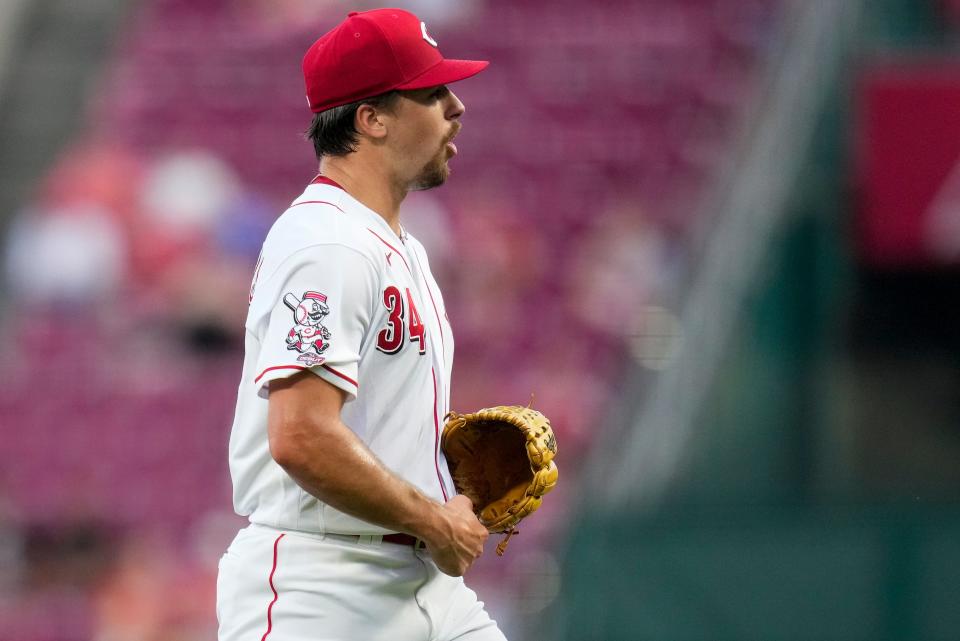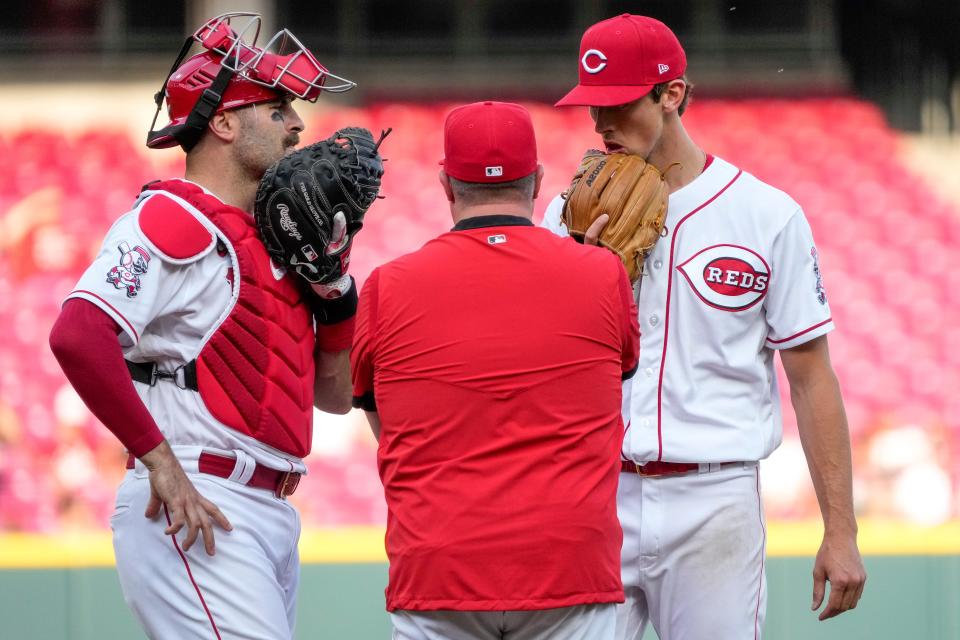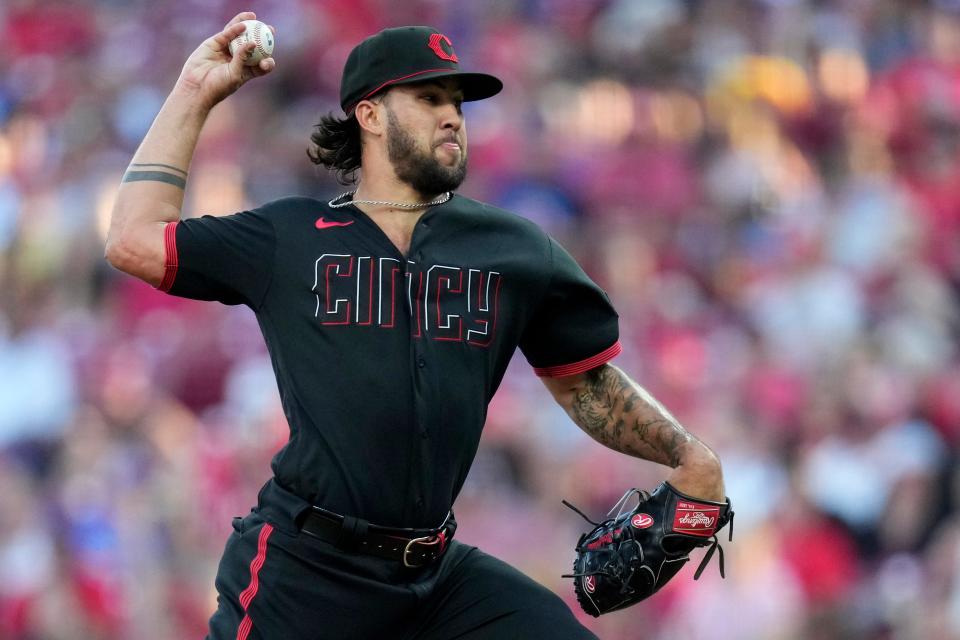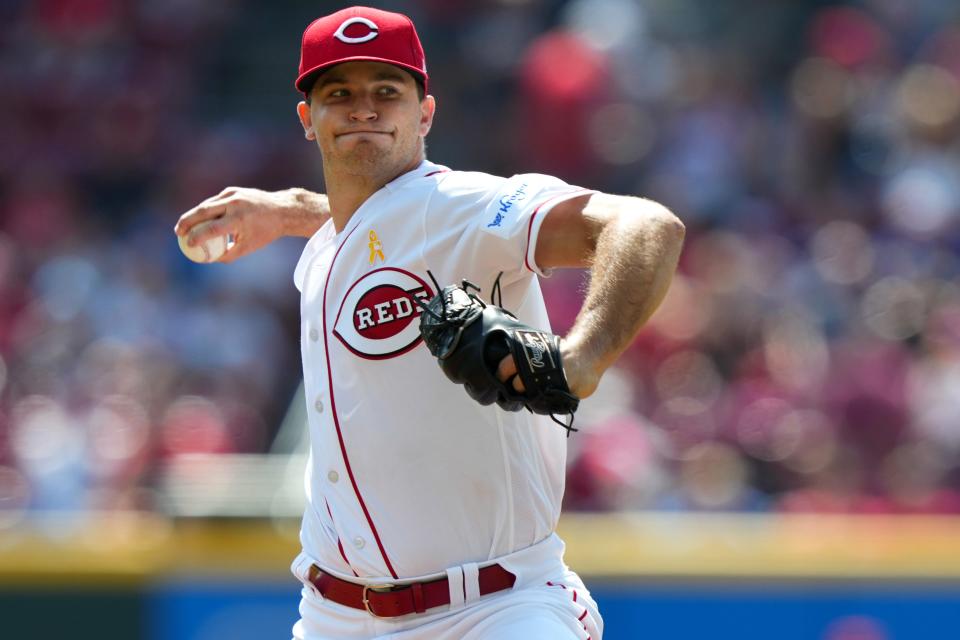The Reds saved their 2023 season through improved pitching development
The Cincinnati Reds’ season could have ended with Nick Lodolo’s season-ending injury setback, Graham Ashcraft’s toe injury and a COVID outbreak that wiped out three starting pitchers for a week.
Coming off of a challenging and taxing West Coast road trip, the Reds returned home and realized they needed to scramble to find pitching for two pivotal series.
Lyon Richardson, who was nearing an established innings limit, was called back up and asked to pitch deeper into games than he had been pitching all season. Carson Spiers was called up from Double-A. Connor Phillips spent the month of August working on adjustments in Triple-A, but then he was called up to join a rotation in the playoff race.
Reds returning players Joey Votto returns to Cincinnati Reds lineup for playoff push Sunday against Cardinals
Reds home stretch Cincinnati Reds: 10 questions for 20 games, from Joey Votto to bullpens to Elly De La Cruz
Reds final games 'No mercy.' Here's why the Cincinnati Reds are looking forward to the stretch run
The Reds started the year with Hunter Greene, Lodolo, Ashcraft, Luis Cessa and Connor Overton in the rotation. Brandon Williamson, Ben Lively and Andrew Abbott joined the mix in the middle of the season.
The Reds needed a third wave of starting pitchers with Richardson, Spiers and Phillips over the last week. And as the Reds split a series against the Chicago Cubs and wont a series against the Seattle Mariners, that third wave of pitchers saved the Reds’ season.
“Having the ability to have the depth in an organization in a time of need for our team, to be able to put talented, quality, young pitchers who were prepared to give us a chance to win, that’s saying a lot about them,” Reds manager David Bell said. “It says a lot about our organization.”

The Reds were in the exact same position in 2021, and their pitching depth failed them down the stretch. Even though starting pitcher Vladimir Gutierrez was clearly fatigued and worn out in September, they took as much time as they could before they shut him down. Wade Miley pitched through a neck strain because he knew how badly the Reds needed him. Riley O’Brien and Reiver Sanmartin were the reinforcements available in Triple-A, and neither of them was ready to pitch in a playoff race.
Two years later, the Reds are in the wild card hunt because of how much they’ve gotten from rookie pitchers who weren’t even supposed to be in the big leagues this season.
“We have guys stepping in not just to pitch, they’re here ready to win,” Bell said. “That’s so important to us.”
The evolution of the Reds’ pitching depth took off after the 2021 season. That year, most of the Reds’ top pitching prospects outside of Hunter Greene and Nick Lodolo were hurt or underperforming. After the season, the Reds promoted pitching coach Derek Johnson to be the team’s director of pitching. In addition to his role as the team’s pitching coach, Johnson gained the ability to shape the organization’s initiatives and philosophy for pitching development.
Johnson hired new co-coordinators, Bryan Conger and Casey Weathers, who have shaped the Reds’ pitching prospects on a daily basis. Together, they identified strategies that let pitchers like Andrew Abbott, Brandon Williamson, Richardson, Spiers and Phillips maximize their potential.
“The Reds really take the time before they draft you to get to know who you are,” Abbott said. “They also identify a few things that can really help you. It could be a strength thing, a pitch shape. They sit down and talk with you during the offseason, hammer out a plan and use you wisely.”

Heading into the season, the strength of the Reds was supposed to be Hunter Greene, Nick Lodolo and Graham Ashcraft leading the Reds’ rotation. Greene was on the injured list for two months, Lodolo has missed nearly the entire year and Ashcraft may miss the rest of the season with a toe injury.
As a result, the Reds had to press rookies into action. None of these rookies were standout prospects.
Abbott was a second-round pick who had gone undrafted the year before the Reds picked him. Richardson was a second-round pick who missed the 2022 season after having Tommy John surgery. Phillips was the player to be named later in a trade with the Mariners in 2022. Spiers was an undrafted free agent. The exception was Williamson, but even Williamson struggled pitching consistently in the minor leagues.
This year, all of those pitchers have reached their best case scenarios. Even though the final lines from Phillips, Richardson and Spiers wouldn’t win them any awards, they exceeded the Reds’ expectations.
Before they made it to the big leagues, these pitchers barely even had any experience in Triple-A. But in the minor leagues, they found strategies that helped them develop more quickly.
“We’ve fine tuned our philosophy,” Johnson said. “There isn’t any question about where we’re trying to lead these guys or what we’re trying to do to get them here. At the end of the day, no matter how you slice it, it’s about them understanding themselves. We’ve done a better job of that. We want analytics to play a role with technology. We also need the human side of it, figure out who these kids are and know what can make them even better.”

With the Reds’ organization, Abbott identified ways to give his fastball more of a rising effect, learned how to game plan and sequence pitches and developed a changeup. Williamson evolved from a fastball-curveball pitcher to a cutter-slider pitcher.
Phillips improved his command, added movement to his slider, and became an elite strikeout pitcher in the minor leagues. Last Tuesday, he kept the Reds in the game against the Mariners by pitching 4 ⅔ innings. He allowed five runs, which was mostly a product of one swing by Mariners star outfielder Julio Rodríguez. Phillips also struck out seven batters and blew past the Mariners’ lineup with his fastball.
Richardson developed one of the most interesting changeups in baseball with a rare amount of horizontal movement, and he built his velocity up to 100 mph. Last Friday against the Cubs, Richardson loaded the bases with walks in the first inning, escaped the jam and went on to allow just two runs in 4 ⅔ innings in a Reds win.
The most unlikely success story has been Spiers, who was an average reliever in college and redesigned his entire approach on the mound. He allowed three runs in four innings in his debut, but he also struck out seven batters. He showed the Reds enough to earn another start. Spiers’ aggressiveness and command are all connected to improvements that he made in the Reds’ farm system.
“We got in the lab and really broke down pitch shapes,” Spiers said. “That helped my arsenal grow in many ways. I’m able to actually reflect on my outings and actually see where my pitches are rather than waiting and seeing what happens in games. I can get feedback and know what I can look at to get myself back on track.”

Instead of going all-in on analytics or all-in on traditional pitching methods, Johnson’s goal has been establishing a method that “mixes the arts and the sciences.”
The same coaching style doesn’t work for every pitcher, and Johnson said the Reds may have missed chances to develop certain pitchers when they had a more rigid philosophy.
The Reds’ playoff hopes picked up a second wind over the last two weeks as rookie pitchers picked up a rotation that could have crumbled due to injuries and COVID. Even though the Reds didn’t win Spiers’ or Richardson’s most recent starts, they logged efficient innings and saved the bullpen. In the process, they had enough impressive moments that will put them in the mix for a full-time rotation spot in 2024.
The Reds can confidently say that they have built the pitching depth that they lacked two years ago. Johnson acknowledged that there’s still work to do, but the Reds’ recent success is a product of years of successful player development.
“We’re in a good enough spot,” Johnson said. “To say that I’m content with where you’re at, you can’t be. I know there will be a point where we’re trying to figure things out. I feel good about our players, I feel great about our pitching coordinators working day-to-day, and I think they’ve done a great job. At the same time, we can push them to be better. I’ll push myself to be better. We push our pitchers to be better.”
This article originally appeared on Cincinnati Enquirer: The Reds saved their 2023 season through improved pitching development

